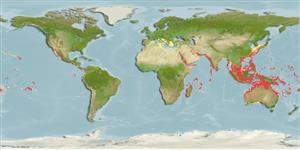Common names from other countries
Classification / Names / Names
Namen | Synonyme | Catalog of Fishes (gen., sp.) | ITIS | CoL | WoRMS
Environment: milieu / climate zone / depth range / distribution range
Ökologie
Riff-verbunden; tiefenbereich 1 - 110 m (Ref. 101020). Tropical
Indo-Pacific and the Mediterranean: from East and South Africa, to western Polynesia; north to Japan and south to central Queensland and New Caledonia.
Length at first maturity / Size / Gewicht / Alter
Maturity: Lm ? range ? - ? cm Max length : 4.0 cm SHL Männchen/unbestimmt; (Ref. 349); common length : 3.0 cm SHL Männchen/unbestimmt; (Ref. 349)
Sometimes found in local markets (Ref. 349). Shallow subtidal zones (Ref. 349). Most Nassariidae are omnivores and facultative scavengers (Ref. 108572).
Life cycle and mating behavior
Geschlechtsreife | Fortpflanzung | Ablaichen | Eier | Fecundity | Larven
This species is a non-broadcast spawner. Life cycle does not include trocophore stage. Also Ref. 833.
Poutiers, J.M. 1998. (Ref. 349)
IUCN Rote Liste Status (Ref. 130435)
CITES Status (Ref. 108899)
Not Evaluated
Not Evaluated
Nutzung durch Menschen
| FishSource |
Tools
Mehr Information
Alter/Größe
Wachstum
Länge-Gewicht
Länge-Länge
Morphologie
Larven
Dichte
Internet Quellen
Estimates based on models
Preferred temperature
(Ref.
115969): 23.6 - 29.1, mean 28 (based on 2396 cells).
Verwundbarkeit
Low vulnerability (10 of 100).
Preiskategorie
Unknown.
